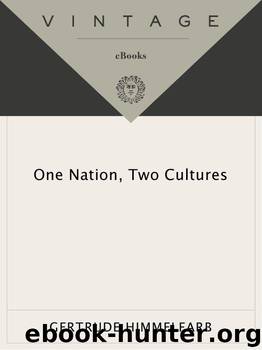One Nation, Two Cultures: A Searching Examination of American Society in the Aftermath of Our Cultural Rev olution by Gertrude Himmelfarb

Author:Gertrude Himmelfarb [Himmelfarb, Gertrude]
Language: eng
Format: epub
Publisher: Knopf Doubleday Publishing Group
Published: 2010-12-15T08:00:00+00:00
The current revival, which has been called the Fourth Great Awakening, originated in the 1960s and continues to this day. The label reminds us that this is not a new (for many, a frighteningly new) phenomenon that we are witnessing but a familiar one. Yet it is even more diverse, theologically and socially, than the earlier ones. The movement as a whole—about 60 million people in 1988, the historian Robert Fogel estimates, or about a third of the adult population—is dominated by the fundamentalist, pentecostal, and charismatic Protestant denominations (generally lumped together under the label “evangelical”); but it also includes as many as 20 million members of the mainline Protestant churches, 6 million “born again” Catholics, and almost 5 million Mormons.19 These estimates vary widely, depending upon the definition of the terms. In a survey conducted in 1996, evangelicals were found to constitute one-fourth to one-fifth of the population;20 in others, based upon more rigorous theological criteria, one-sixth to one-tenth.21 Perhaps more significant is the number of people who describe themselves as “born again” or “evangelical”—almost half of the respondents in one poll in 1998.22
However defined, evangelicalism should not be confused with the “religious right,” as it has been called—the conservative activist movement that has emerged so prominently in the political arena.* In one survey, only one-third of the evangelicals identify with the religious right;24 in another, only one-fifth do.25 Evangelicals are more varied, not only theologically and denominationally but also politically, than the popular image would have it. Not all are fundamentalist, or fundamentalist to the same degree. And not all are conservative, or conservative to the same degree. Whereas most adherents of the religious right are Republicans, almost half of the evangelicals who are not of the religious right are Democrats.26 (In the election of 1998, it was reported that 40 percent of “religious conservatives” voted Democratic.27)
Moreover, neither evangelicals nor the religious right conform to the familiar social stereotypes. They are not red-necked, retrograde philistines living in rural areas, fearful of change and modernity, anxious about their jobs and future. The evangelicals are, in fact, more highly educated than those calling themselves either religious liberals or secularists, and only slightly less likely to have had a graduate education than mainline Protestants. In other respects—employment, income, urban residence—they fit the pattern of the population at large.28 The religious right differs even more from the stereotype. It consists of more women than men; almost half are between the ages of thirty-five and forty-nine; almost half live in the South; and in income, education, and social status they outrank both evangelicals in general and the population at large.29
All, however—evangelicals and the religious right—feel alienated from a culture that they see as inimical to both their religious and their cultural values. Stephen Carter tells the story of two black evangelical women who moved from liberal political groups to conservative ones for no other reason than the feeling that the liberals did not respect their religiosity. “They preferred a place,” Carter comments, “that
Download
This site does not store any files on its server. We only index and link to content provided by other sites. Please contact the content providers to delete copyright contents if any and email us, we'll remove relevant links or contents immediately.
| Coloring Books for Grown-Ups | Humor |
| Movies | Performing Arts |
| Pop Culture | Puzzles & Games |
| Radio | Sheet Music & Scores |
| Television | Trivia & Fun Facts |
The Social Psychology of Inequality by Unknown(2940)
Make Comics Like the Pros by Greg Pak(2852)
Stacked Decks by The Rotenberg Collection(2811)
Purple Hibiscus by Chimamanda Ngozi Adichie(2651)
The Queen of Nothing by Holly Black(2494)
The Art of Doom by Bethesda(2107)
Life of Elizabeth I by Alison Weir(2026)
Putin's Labyrinth(1960)
The Power of Habit: Why We Do What We Do in Life and Business by Charles Duhigg(1940)
Drawing Down the Moon by Margot Adler(1824)
Things Are What You Make of Them: Life Advice for Creatives by Adam J. Kurtz(1817)
Wall and Piece by Banksy(1781)
Agency by William Gibson(1778)
Art Of Atari by Tim Lapetino(1750)
Teaching to Transgress: Education as the Practice of Freedom (Harvest in Translation) by Bell Hooks(1694)
The Beatles Lyrics by Hunter Davies(1672)
The Pin-Up Art of Bill Ward by Bill Ward(1651)
Only What's Necessary: Charles M. Schulz and the Art of Peanuts by Chip Kidd(1646)
The Andy Warhol Diaries by Andy Warhol(1562)
